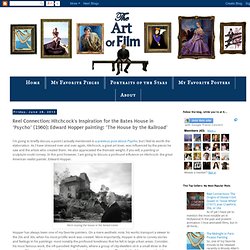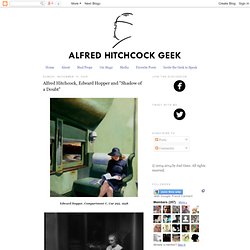

Reel Connection: Hitchcock's Inspiration for the Bates House in "Psycho" (1960): Edward Hopper painting: "The House by the Railroad" I'm going to briefly discuss a point I actually mentioned in a previous post about Psycho, but I feel its worth the elaboration.

As I have stressed over and over again, Hitchcock, a great art lover, was influenced by the pieces he saw and the artists who created them. He also appreciated the thematic weight, if you will, a painting or sculpture could convey. In this post however, I am going to discuss a profound influence on Hitchcock: the great American realist painter, Edward Hopper. Hopper has always been one of my favorite painters. On a mere aesthetic note, his works transport a viewer to the 20s and 30s, when his most prolific work was created.
Of note, the set for the Bates House was used and recycled by Universal for years. I have to say, as great as I think this post is, if you enjoy it, you should check out a series of Hopper-related posts that the "Alfred Hitchcock Geek" blog has. Alfred Hitchcock Geek: Alfred Hitchcock, Edward Hopper and "Shadow of a Doubt" Edward Hopper, Compartment C, Car 293, 1938 The 39 Steps, 1935 Hopper, Night Shadows, 1921 The 39 Steps "If you could say it in words, there'd be no reason to paint.

" — Edward Hopper "They were aroused by pure film. " In his day, Alfred Hitchcock had many thousands of fans. At the same time, Hopper, an inveterate movie-goer, had seen many of Hitchcock's films. Of course, Hitchcock wasn't alone in noticing Hopper's cinematic virtues. He remains a huge influence. As the pictures above show, there are similarities in the way Hitch and Hopper created their images. Voyeurism, loneliness, isolation: these are themes that Hitch and Hopper share, and they're easy to spot in their respective works. Nighthawks, 1942 "Hopper is always on the verge of telling a story," observed John Updike, and the half-stories he told were often tinged with melancholy, if not malice. Hitchcock - Hopper. Edward Hopper, Night Windows 1928 top Alfred Hitchcock, Rear Window 1954 above As discussed on Monday, the connection between Hitchcock and Edward Hopper.

On further investigation it seems the connection was sometimes almost literal as seen above but the themes of urban isolation and loneliness and, above all, that we are all voyeurs threads through both. The huge sound stage used for Rear Window was created to look like Greenwich Village in New York which is also where Hopper did many of his night paintings. The interior spaces are often shown as small cocoons of light where the occupants are aware only of their small parcel of space.
The device of viewing an interior from outside, as a voyeur, makes for a fragmented picture of peoples' lives and their environments. Réalisme américain. La scène américaine Le réalisme américain récupère l’esprit et les traditions américaines à travers un récit figuratif qui prétend être réaliste et efficace dans son message social.

Ce mouvement développe les racines visuelles du réalisme du XIXe siècle, les conduisant vers des nouveaux problèmes spatiaux occasionnés par une perception différente du paysage métropolitain. La nouvelle physionomie architectonique de la ville moderne, le paysage urbain et industriel presque dépouillé de la représentation humaine, se réinterprète avec un réalisme très marqué. Une tendance qui célèbre la société américaine, la confiance en soi-même dans son progrès technologique et industriel. Dans les arts figuratifs de la « scène américaine », la réflexion se concrétise dans la poétique du régionalisme et du réalisme social. Hopper-social-01-2014.jpg (JPEG Image, 600 × 375 pixels) Hopper1954.031morning-sun_enl-93e7ac83669b624b0371fffb6cd76e7780c1c727.jpeg (JPEG Image, 1963 × 1362 pixels) - Scaled (52%) Edward-hopper-excursion-into-philosophy1.jpg (JPEG Image, 700 × 527 pixels) Edward-hopper-room-in-new-york.jpg (JPEG Image, 600 × 536 pixels)
Edwardhopper1.jpeg (JPEG Image, 771 × 489 pixels) 366_hopper.jpg (JPEG Image, 366 × 282 pixels)